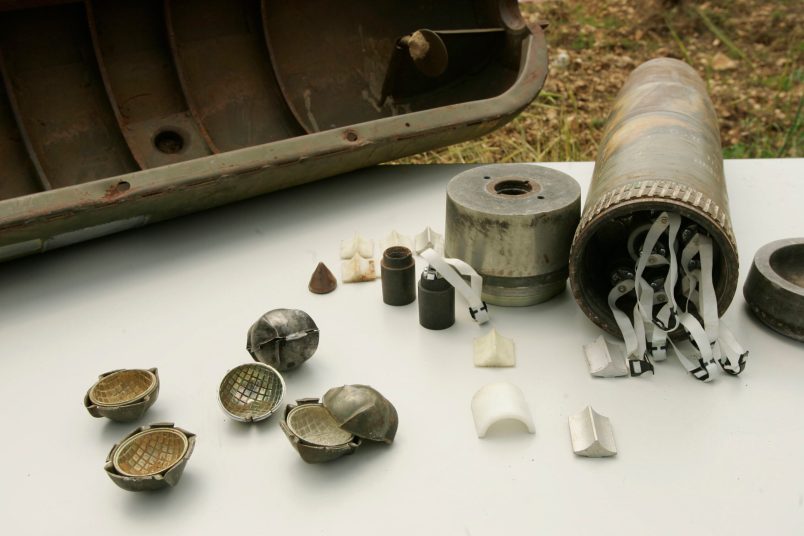The Biden administration’s decision to provide Ukraine with cluster munitions earlier this month set off a furious debate, with many Democrats and a few MAGA Republicans trying to move a measure through Congress which would block the U.S. from transferring the bombs.
They’re terrifying weapons, which a slim majority of countries in the world have tried to ban. Fired in canisters with ribbons attached to miniature bombs within, they catch the wind in midair, opening up to spread the bomblets, devastating a huge swath of ground beneath. Mineclearers find oval-shaped “footprints” of explosions created by the weapons, as well as ordnance that has gone undetonated, waiting to do damage years or decades later.
Now, with the West running out of spare artillery ammunition to send its ally, and with Ukraine fighting through thick minefields to liberate its south, both Kyiv and the White House have come to see the weapons as necessary. Dozens of members of Congress and many human rights groups have strongly disagreed.
From the perspective of some of those on the ground, the debate is academic, and the cluster munitions themselves yet another example of the dire effects of the war for survival that Russia has inflicted on the country.
“Of course it’s a tragedy, but everything right now is a tragedy,” Andriy Zagorodnyuk, a former defense minister of Ukraine told TPM of the bombs’ employment. “So the question is how to end the tragedy and, unfortunately, the only way so far to get peace is to win the peace.”
‘Unlivable in any case’
There are two features that make cluster bombs particularly dangerous in a way that extends far beyond their use on the battlefield. First, a relatively large proportion of the bomblets fail to detonate. Years after a conflict, the unexploded bombs can litter old battlefields, presenting a mortal threat to children, workers — whoever is unlucky enough to encounter them.
Separately, unlike other weapons, cluster munitions do not self-destruct. Instead, they slowly degrade, becoming more explosive unless defused and removed.
That’s led 108 countries to sign a treaty banning the bombs’ production, use, and transfer. Russia, Ukraine, and the U.S. have not signed.
Whether to use them — with all the attendant risks of civilian harm down the line — is a live moral debate. Various sides in the argument tend to fall, as retired Marine colonel and RAND analyst David E. Johnson framed it last year during a debate over a different weapons system, over whether the cause — removing Russia’s occupation — matters more than the weapon — cluster bombs that can linger for years.
Zagorodnyuk was Ukraine’s defense minister for the first year of Zelensky’s government, from 2019 through March 2020. He now runs a Kyiv-based think-tank called the Center for Defense Strategies, which advises the government on military matters.
Like a lot of Ukrainians in and around the government, Zagorodnyuk is extremely circumspect in choosing his words with Western journalists. He’s assiduous in conveying that even if cluster bomb deliveries were to be blocked, his country remains incredibly grateful for the help that the United States, and the rest of the West, has provided.
Zagorodnyuk described the decision to use the weapons as difficult, and emphasized in a conversation with TPM that Ukraine’s armed forces had provided assurances that they would not use them in populated areas. He argued that Ukraine saw them as fit for a specific purpose: punching through depopulated regions filled with Russian mines and trench networks.
“We’re talking about areas that are completely unlivable in any case,” he said. “It’s not like were taking a thriving area.”
From Ukraine’s perspective, Zagorodnyuk said, the problem of unexploded ordnance in areas already covered with mines, shells, and other battle detritus did not compare to the horrors of Russian occupation.
“We would love to see another option,” he added. “But at the moment, the Russians are absolutely determined to continue. So we need to win.”
Zagorodnyuk also emphasized that one argument in favor of Ukraine using the bombs — Russia’s wanton use of cluster munitions, including their employment early on in the war against the Ukrainian city of Kharkiv — was not, in his opinion, the correct way to justify Ukraine’s decision to use the weapons. Unlike the Russians, Ukrainians have to live in Ukraine, Zagorodnyuk noted.
“Russia destroyed our cities, wiped out our villages and so on,” he said. “We have to fight very differently.”
Cross-partisan split
In the U.S., the debate around whether the administration should have greenlit these weapon shipments does not split cleanly along party lines in Congress, though members of each party oppose providing the munitions for different reasons.
After the Biden administration announced its decision this month, 19 House Democrats signed a letter suggesting that sending the bombs would “undermine the United States’ leadership in advocating for human rights around the world, enable indiscriminate harm that will only further endanger Ukrainian civilians.” Rep. Adam Schiff (D-CA), who did not sign the letter, said he opposed the measure, while Sens. Bernie Sanders (I-VT) and Tim Kaine (D-VA) said the same, citing humanitarian concerns.
In March, the top Republican members of the Senate and House foreign affairs and armed services committees urged the Biden administration to send Ukraine the weapons. Sens. Tammy Duckworth (D-WI), Mark Kelly (D-AZ), Joe Manchin (D-WV), and Lisa Murkowski (R-AK) issued statements supporting their provision after the Biden administration announced it.
On the right, MAGA Republicans long opposed to U.S. support to Ukraine used the debate as another cudgel.
Rep. Matt Gaetz (R-FL) said he would co-sponsor a measure brought by some House progressives to ban shipments of the cluster munitions overseas before Republicans on the House Rules Committee tanked the proposal earlier this month.
Bombs away
Whether Congress eventually blocks further cluster bomb shipments or not, Ukraine will remain littered with gargantuan amounts of high explosives of various kinds. Some of them are cluster bombs already fired by both sides in the conflict; others are mines, unexploded shells, missiles, and other dangerous items.
President Zelensky has said that defusing and removing unexploded bombs and mines from Ukraine should take less than a decade due to its urgency. Zagorodnyuk told TPM that Ukraine is documenting their usage for future clearing operations.
But it’ll be a massive task.
“The international community, by providing all of the ammunition, shoulders at least some of the responsibility for demining,” Alex van Roy, a former Australian army combat engineer who oversaw mine clearing operations in Bosnia, told TPM.
Now, van Roy is in charge of Ukraine’s ordnance removal for FSD, a Geneva-based demining foundation which receives funding from the State Department. Without funding, van Roy said, the scale of the violence means that the project to make the country safe could take decades.
Van Roy worked in Lebanon after the country’s 2006 war with Israel, and encountered the the same types of U.S.-produced cluster munitions that are being provided to Ukraine, called Dual Purpose Improved Conventional Munitions (DPICM).
Van Roy recalled in an interview with TPM from Geneva that in Lebanon, around 10 to 15 percent of the DPICMs failed to detonate, for various reasons; some were duds, others would hit the ground too slowly or at an angle, others would get caught in shrubs or olive trees.
He said that clearers would search square meter plots with advanced metal detectors, identifying “footprints” left behind by the cluster bombs that had exploded high above.
DPICMs, he said, are full of hard metal and ball bearings — the kind of material which makes the bombs dangerous for vehicles and people, but relatively simple to locate with the kinds of sensitive metal detectors that his teams use for clearing operations. Some of the types of mines spread around Ukraine only contain small amounts of metal in an effort to make them harder to detect, he said, presenting a more difficult problem for clearance.
“If they’re combined with mines and other unexploded ordnance, then you need to triage for the highest difficulty and danger, which are the land mines. So you clear them first, and you log every metal object you find along the way,” he said, describing the addition of cluster bombs as a “hassle.”
“It would be preferable for everyone concerned that they not be used,” he said. “But the cat’s out of the bag already. Both sides have already been using them. So, there’s going to be more now.”






